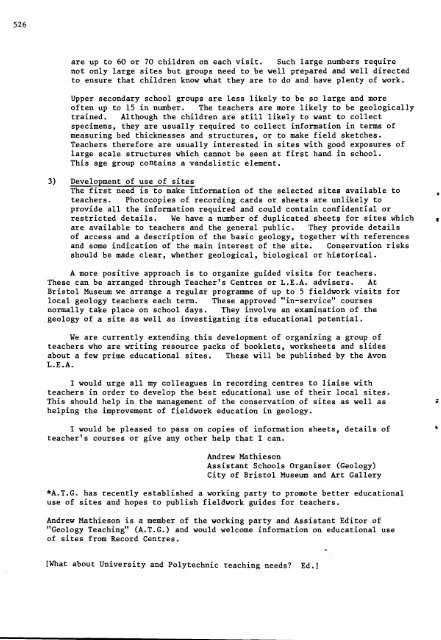E;*+ - Geological Curators
E;*+ - Geological Curators
E;*+ - Geological Curators
Create successful ePaper yourself
Turn your PDF publications into a flip-book with our unique Google optimized e-Paper software.
3)<br />
are up to 60 or 70 children on each visit. Such large numbers require<br />
not only large sites but groups need to be well prepared and well directed<br />
to ensure that children know what they are to do and have plenty of work.<br />
Upper secondary school groups are less likely to be so large and more<br />
often up to 15 in number. The teachers are more likely to be geologically<br />
trained. Although the children are still likely to want to collect<br />
specimens, they are usually required to collect information in terms of<br />
measuring bed thicknesses and structures, or to make field sketches.<br />
Teachers therefore are usually interested in sites with good exposures of<br />
large scale structures which cannot be seen at first hand in school.<br />
This age group contains a vandalistic element.<br />
Development of use of sites<br />
The first need is to make information of the selected sites available to @<br />
teachers. Photocopies of recording cards or sheets are unlikely to<br />
provide all the information required and could contain confidential or<br />
restricted details. We have a number of duplicated sheets for sites which 4<br />
are available to teachers and the general public. They provide details<br />
of access and a description of the basic geology, together with references<br />
and some indication of the main interest of the site. Conservation risks<br />
should be made clear, whether geological, biological or historical.<br />
A more positive approach is to organize guided visits for teachers.<br />
These can be arranged through Teacher's Centres or L.E.A. advisers. At<br />
Bristol Museum we arrange a regular programme of up to 5 fieldwork visits for<br />
local geology teachers each term. These approved "in-service" courses<br />
normally take place on school days. They involve an examination of the<br />
geology of a site as well as investigating its educational potential.<br />
We are currently extending this development of organizing a group of<br />
teachers who are writing resource packs of booklets, worksheets and slides<br />
about a few prime educational sites. These will be published by the Avon<br />
L.E.A.<br />
I would urge all my colleagues in recording centres to liaise with<br />
teachers in order to develop the best educational use of their local sites.<br />
This should help in the management of the conservation of sites as well as<br />
helping the improvement of fieldwork education in geology.<br />
I would be pleased to pass on copies of information sheets, details of<br />
teacher's courses or give any other help that I can.<br />
Andrew Mathieson<br />
Assistant Schools Organiser (Geology)<br />
City of Bristol Museum and Art Gallery<br />
*A.T.G. has recently established a working party to promote better educational<br />
use of sites and hopes to publish fieldwork guides for teachers.<br />
Andrew Mathieson is a member of the working party and Assistant Editor of<br />
"Geology Teaching" (A.T.G.) and would welcome information on educational use<br />
of sites from Record Centres.<br />
[What about University and Polytechnic teaching needs? Ed.]

















